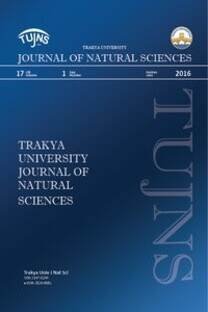Landsat TM ve IRS Uydu Görüntülerinin Arazi Kullanımı ve Bitki Örtüsü Değişimlerini Belirleme Çalışmalarında Kullanımlarının Karşılaştırılması
Doğruluk Analizi , Sınıflama, Indian Remote Sensing (IRS), Landsat TM
A COMPARISON OF LANDSAT THEMATIC MAPPER AND INDIAN REMOTE SENSING DATA FOR LAND USE AND LAND COVER CHANGE ASSESSMENT
Accuracy, Classification, Indian Remote Sensing, Landsat TM,
___
- 1. ANDERSON, J. R., HARDY, E. E., ROACH, J. T. AND WITMER, R. E., 1976. A Land Use and Land Cover Classification System for Use with Remote Sensor Data. U.S. Geological Survey, Professional Paper 964, p. 28, Reston, VA.
- 2. CONGALTON, R. G. 1996. Accuracy Assessment: A Critical Component of Land Cover Mapping. GAP Analysis. ISBN 1-57083-03603 American Society for Photogrammetry and Remote Sensing. 1996.
- 3. CONGALTON, R. G., AND K. GREEN. 1999. Assessing the Accuracy of Remotely Sensed Data. CRC Press, Boca Raton, FL. 137 pp
- 4. ERDAS, 2001. ERDAS Field Guide. Earth Resources Data Analysis System. ERDAS Inc. Atlanta, Georgia.
- 5. FOF, 2002. 1000 Friends of Florida. Building Better Communities. Source: http://www.1000friendsofflorida.org/PUBS/stmarksGreen/apend2.asp Assessed 05/01/2002.
- 6. JENSEN, J.R., 1996. Introductory Digital Image Processing, A Remote Sensing Perspective. Prentice Hall. Upper Saddle River, New Jersey.
- 7. JENSEN, J.R., 2000. Remote Sensing Of The Environment, An Earth Resource Perspective. Prentice Hall. Upper Saddle River, New Jersey, p.220.
- 8. LILLESAND, T.M., AND KIEFER, R.W. 2000. Remote Sensing and Image Interpretation.4th Edition. John Wiley & Sons. New York, p.431.
- 9. LUNETTA, R.S., AND BALOGH, M.E., 1999. Application of Multi-Temporal Landsat 5 TM Imagery for Wetland Identification. Photogrammetric Engineering and Remote Sensing. Vol.65. No.11, p.1303-1310.
- 10. PRICE, K.P., PIKE, D.A., AND MENDES, L. 1992. Shrub Dieback in a Semiarid Ecosystem: The Integration of Remote Sensing and Geographic Information Systems for Detecting Vegetation Change. Photogrammetric Engineering and Remote Sensing. Vol.58. No.4, p.455-463.
- 11. RAM, B., AND KOLARKAR, A.S. 1993. Remote Sensing Application in Monitoring Landuse Changes in Arid Rajasthan. International Journal of Remote Sensing. Vol.13, p.2783-2799.
- 12. RICHARDS, J. A., AND JIA, X., 1999. Remote Sensing Digital Imaging Analysis: An Introduction. 3rd Edition. Springer-Verlag. New York, NY.
- 13. ROBINOVE, C. J. 1981. The Logic of Multispectral Classification and Mapping of Land. Remote Sensing of Environment. Vol. 11, p.231-244.
- 14. SMITH, K.G., DZUR, R.S., CATANZARO, D.G., GARNER, M.E., AND LIMP F.W. 1998. Statewide Biodiversity Mapping for Arkansas. The Arkansas GAP Analysis Final Report. Cooperative Agreement No.14-16-0009-1567. Source: http://www.cast.uark.edu/gap/preface.htm. Accessed 03/10/2002.
- 15. SWAIN, P.H., AND DAVIS, S.M. 1978. Remote Sensing: The Quantitative Approach. McGraw-Hill. New York, NY.
- 16. THOMAS, I.T., BENNING, V.M., AND CHING, N.P. 1987. Classification of Remotely Sensed Images. IOP Publishing Ltd. Bristol, England.
- 17. USGS, U.S. Geological Survey, 2002. Digital Orthophoto QuadranglesSource: http://spatialnews.geocomm.com/education/tutorials/doq1/usgs_doq.html#doq16. Accessed 03/01/2002.
- 18. WOLF, P.R., AND DEWITT, B.A., 2000. Elements of Photogrammetry with Applications in GIS. 3rd Edition. McGraw-Hill Companies Inc. New York
- ISSN: 1305-6468
- Başlangıç: 2000
- Yayıncı: -
Binalarda kullanılan yüksek teknoloji ürünü saydam elemanların ısıl ve optik özellikleri
FİLİZ UMAROĞULLARI, Semiha KARTAL
ÇOK AMAÇLI DOĞRUSAL KESİRLİ PROGRAMLAMA PROBLEMİNİN TAYLOR SERİSİYLE ÇÖZÜMÜ
ORNİTHOGALUM UMBELLATUM L. BİTKİSİNDEKİ FLAVONOİDLER
TEMİNE ŞABUDAK, Özlem DEMİRKIRAN, Ülkü OYMAN
Aida ŞAHMUROVA, Elçin HEPSAĞ, Asude ÖZKAN
Saros Körfezi kıyı kumulları üzerindeki çevresel etkilerin araştırılması
Türk bahçe sanatına bir Örnek: Edirne sarayı bahçesi
Leman TARHAN, Hülya Ayar KAYALI
Assessment of principal component analysis (PCA) for moderate and hıgh resolution satellite data
BİNALARDA KULLANILAN YÜKSEK TEKNOLOJİ ÜRÜNÜ SAYDAM ELEMANLARIN ISIL VE OPTİK ÖZELLİKLERİ
Filiz UMAROĞULLARI, Semiha KARTAL
EBABİL (Scopoli, 1777) TÜRLERİNİN TÜRKİYE'DEKİ DAĞILIMI VE TAKVİMİ ÜZERİNE ARAŞTIRMALAR
